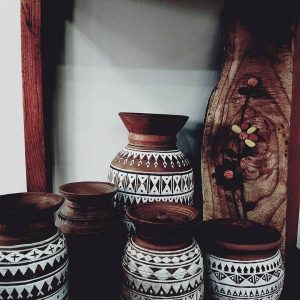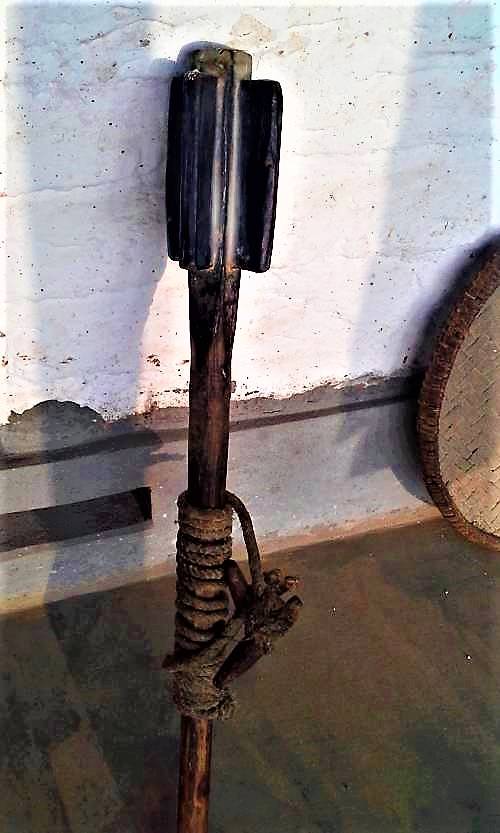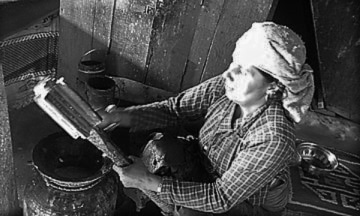The Theki and Madani are the traditional tools used in the process of butter churning in Nepal.

The Nepalese consume butter, milk, and curds in abundance. Likewise, ghee is a part of every cultural program and is also used to enhance food taste. If you didn’t know, the devices used to extract ghee are the antique Madani and Theki.
But we can only see such classic devices in a few rural households or museums. As technology takes over, we are slowly leaving our traditional instruments behind. The outcomes are overwhelming as well as saddening. So, today we will look into these age-old practices of butter churning in Nepal.
The Traditional Butter Machine, Theki
The Theki is a cylindrical wooden flask used to store curd. This is the largest and main device used in churning butter. The flask has a round, narrow neck. The upper head part is like an open bowl. Traditional Theki’s are mainly made up of Darigitho wood. Thus, some even call it “Daar Ko Theki.” In the mountainous areas where Darigitho wood is not found, carpenters use Rhododendron wood to make Theki.
The Theki is mainly a storage device for curd before and during the curing process. First, we boil the excess milk and then keep it in the Theki. After leaving it for a few hours, the milk settles and becomes curd, from which we extract butter through churning.
Madani (Ghupa)
Madani (Ghupa) comes along with Theki. This is the main device used to stir the stored curd in the Theki. It comprises three parts: the cylindrical rod-like structure (Saro), wooden turbines (Pora), and a rope (Neti).
Saro, the rod, comprises Falat or Katus wood. It holds the blade, and the rope used in Madani.
The key component of Madani is the blades at the bottom. The blades have four sides, which stir the curd back and forth. Thus, it can also be called a centrifugal machine.
The other part of the rope is called Neti. The rope is tied to the main rod. So, when pulled back and forth, it causes the rod and the blades to move.

Using Theki and Madani for Butter Churning

First, Theki, full of curd, is fixed near a pillar, making it immobile. Then, the upper part of Madani is tied parallel to the same pillar, keeping the turbines inside Theki. Then, with the help of Neti (rope), the Madani is rotated back and forth continuously. Pulling a rope is the same as cycling but with the use of the hand.
The process takes time. However, some also add hot water, in the beginning, to speed up the process. The activity of pulling Neti (rope) is continued until the butter separates from the curd. After some time, the pure white butter, also called Nauni, settles on the top. This denotes the completion of the process.
Then, the Madani is taken out, and the butter is taken out of the mixture. Then a small amount of white butter is offered to God over a burning heap of coal. The offering releases a sweet smell into the air, making the entire house pure and free from evil energies.
Finally, the remaining white butter (Nauni) is then heated to make clarified butter. The final product, ghee, is then stored in a bottle to be used for religious purposes or to eat as a seasoning with food.
The remaining mixture of curd and hot water, also called Mohi, is then distributed as a refreshment drink. Mohi is a popular homemade drink during the summer months in Nepal.
Theki is inviolable in Nepal. The tool is washed alone, which means it is not washed with other utensils. Washing it with other dishes or touching Theki while eating is considered a disrespect to God.
In the end,
Butter Churning using Theki and Madani is an age-old traditional practice. Nowadays also, if you go on a village trek in Nepal, you can see these tools used for butter churning. But, in other places, these tools are now displaced by some electronic devices. But, people don’t realize that they were more eco-friendly and didn’t need any electrical support.
Nowadays, only a few individuals have these tools in their homes, also as antique pieces. Sadly, we will soon see these devices in pictures, videos, or in museums. In the race of development, people have forgotten the beauty of these environment-friendly traditional devices.











